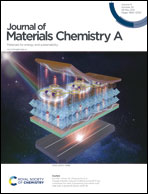Interpenetrating gels as conducting/adhering matrices enabling high-performance silicon anodes†
Abstract
Three-dimensional (3D) conductive polymers are promising conductive matrices for electrode materials toward electrochemical energy storage. However, their fragile nature and weak binding forces with active materials could not guarantee long-term electrode stability and extended cycling life. Herein, adhesive polymer networks have been introduced into conductive polymer networks to form interpenetrating gels, possessing greatly enhanced mechanical stretchability and chemical interactions with active materials. Conducting polypyrrole (PPy) and adhering polyvinyl alcohol (PVA) polymers have been selected as typical examples, and simultaneous gelation reactions for PPy and PVA gels enable the formation of integrative PPy/PVA interpenetrating gels. As a proof-of-concept illustration, the PPy/PVA gels have been utilized as conducting/adhering matrices for Si anodes toward lithium storage. Thanks to the gel-based 3D conductive pathway and adhesive network, the Si@PPy/PVA gel electrode manifests markedly enhanced cycling stability (1834 mA h g−1 after 100 cycles at 0.5 A g−1) and rate capability (1975 and 1543 mA h g−1 at 2 and 5 A g−1, respectively).



 Please wait while we load your content...
Please wait while we load your content...